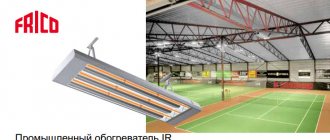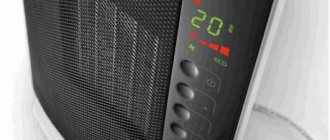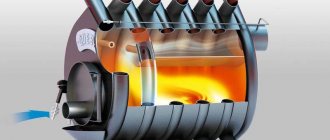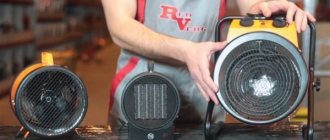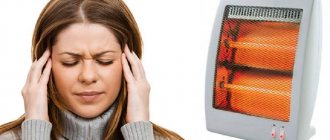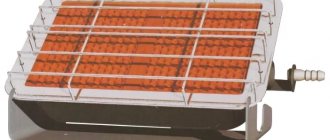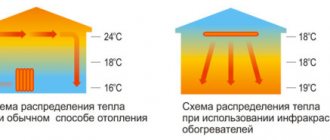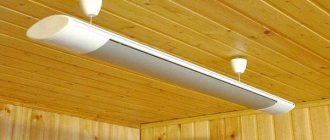Not every dacha has a stove or, especially, full heating. But this is not advisable, given that life outside the city is in full swing in the summer, and in winter people rarely visit the site. However, even in the middle of summer there are cold days, and here a variety of infrared heaters with a thermostat for the dacha can provide invaluable help. Let's understand how the device works, what capabilities it has, and what parameters are used to select it.
A portable heater can be useful even in summer Source grillclub.com.ua
About the operating principle and design
Hydronic heating systems, convectors and oil heaters work in the same way as a fire in a furnace: they heat the air, which in turn gives off heat to surrounding objects. This method of heat transfer (heat exchange) is called convection, and acts omnidirectionally, along with air flows. Traditional convection heating results in the warmest place in the room being under the ceiling, where warm air flows
An infrared (IR) heater works on a different principle. It emits infrared radiation, which is a type of electromagnetic wave (some of which, the visible spectrum, is perceived by the human eye). Most of the radiant energy from such a device is first absorbed by the surface of objects, while the air is heated slightly. Objects heat themselves and then heat the air.
The electromagnetic method of energy transfer can be made directional. This allows you to organize heating of a specific object without pre-heating the entire room (and reduce energy costs).
Difference between convection and infrared heating Source ipic.su
That is why you can feel the thermal effect from the IR device immediately after turning it on. The design of the unit can be represented in the following (schematic) form:
- Emitter. The main element of an IR heater, producing infrared radiation due to heating. Electricity or gas is most often used to heat it. In conventional electrical appliances, a heating element or spiral is used as a heater.
- Reflector. This is a reflector, a radius-shaped surface directed towards the emitter and covered with a layer of heat-resistant metal. Sometimes, to soften the radiation, the surface of the reflector is made matte or uneven.
- Protection. It has the appearance of a metal mesh or a transparent partition, which helps to safely operate the device in rooms with children and pets.
- Thermostat. Allows you to maintain the temperature at a given level. Thanks to the thermostat, the device does not work continuously, but only until the air is heated to the set temperature, after which it turns off.
Directional energy distribution Source elektrika.expert
How does a thermostat work?
The thermostat contains a sensor that receives information regarding the temperature of the space being served.
If its value drops below the lowest temperature that the user has set as comfortable, then a reaction is triggered inside the thermostat; its mechanism can be a bimetallic plate or a relay that closes the circuit, as a result of which the heater is connected to the electrical network.
- As a result, this device begins to function and heats the space.
- At some point, the thermostat sensor detects that the room temperature has reached the upper limit of the specified range.
- Then the power grid is opened again, the heater is disconnected from the network and heating of the space stops for some time.
Pros and cons of IR technology
An infrared emitter is an acceptable option for heating country houses (small in size). It is chosen for a summer residence for the following reasons:
- Installation of the unit does not require complex or time-consuming procedures.
- Infrared rays create local (directional) heating. The result of the device’s operation is felt immediately after switching on.
- Objects heat up first, not the air. That is, to warm up, you don’t have to wait for the room to warm up, as is the case with a fire in a stove or water in pipes.
- The devices are compact, and many are mobile. The latter can be easily moved from one room to another or used on the veranda or gazebo.
- IR heaters are efficient and reliable. They maintain the desired temperature without excessive costs. The warranty period is 8-10 years.
- The devices are environmentally friendly (the IR spectrum is also present in sunlight). They operate silently, do not emit substances hazardous to health, and do not affect the humidity and oxygen of the air. For normal operation, supply and exhaust ventilation is not required.
Street model for comfortable evening gatherings Source zaggo.ru
- The thermostat allows you to save energy.
The disadvantages include the following facts:
- After turning off the unit, the room quickly cools down.
- Heating is carried out zonally, which limits the area of comfortable stay.
- If you do not adhere to the rules of safe operation, you can suffer thermal burns (including the retina). Safety is determined by a combination of two factors: the distance to the device and its power.
GSM controlled devices
These thermostats have a connector into which a SIM card from a telecom operator is placed. After that, it can be controlled from a smartphone remotely; it is only necessary that there is mobile coverage at a given point.
These devices are capable of combining a number of additional functions. Along with maintaining the microclimate in the room, they can take on monitoring the operation of an electric kettle, coffee maker, as well as a boiler and other household appliances.
Variety of characteristics
Before choosing an infrared heater, you need to get acquainted with the types of models offered by manufacturers. Having an idea of the key features of certain devices, you can choose the best option for heating your dacha, garage or greenhouse.
Radiation intensity
IR heaters are capable of emitting thermal energy in the form of waves of different lengths, but within a certain range. The shorter the wavelength, the more energy it carries, and the more powerful the radiation, which affects the characteristics of the unit.
IR heater in the form of a lamp in a gazebo Source terman-s.ru
Based on the radiation range, devices are divided into the following three groups:
- Shortwave. The wavelength falls in the range of 0.7-2.5 microns. Powerful units are not used in homes with standard ceilings due to safety reasons. The scope of application is large-scale premises with a ceiling height of 6-8 m, where hard radiation has time to dissipate, for example, a warehouse, a train station, an industrial workshop.
- Medium wave. Devices whose heating elements generate radiation with a wavelength of 2.5-5.6 microns are suitable for rooms with a ceiling height of 3-6 m. There are no other restrictions, and therefore the device can be installed both in an administrative building or a shopping center, and in private house.
- Long wave. Radiation with a wavelength of 5.6-100 microns is considered a safe option for any residential and industrial premises with ceilings no higher than 3 m. A long-wave heater is a suitable solution for an apartment, cottage, as well as a kindergarten or hospital, as evidenced by sanitary and hygienic standards for heating.
Local principle of heating a wall-mounted IR device Source prom.st
See also: Catalog of companies that specialize in electrical work of any complexity
Energy source
Conveniently, you can choose an infrared heater for your home or cottage based on the type of energy carrier used. Based on the type of energy source, there are three types of devices:
- Operating on liquid fuel (diesel). If we talk about the dacha, this is perhaps the worst option. In order for the operation of such a model to be safe, a separate room is required, which is problematic in dacha conditions. In addition, an IR heater on a diesel engine produces a characteristic odor from spent fuel, and this is difficult to compatible with ideas about healthy country life.
- Gas models. To operate, you need a liquefied gas cylinder, which is quite suitable for heating a summer house. Safe operation implies two conditions. Firstly, you need to take care of quality ventilation. Secondly, a working unit cannot be left unattended.
- Electrical varieties. The most popular models for use at home or countryside, varied in installation method and type of heating element.
Electric models meet all safety requirements Source bestazy.com
Heating element type (for electric models)
Electric IR heaters are divided into two large groups:
- Solid state. The devices only emit heat.
- Quartz. The source of radiation is lamps, so you receive not only heat, but also light.
In turn, quartz electric heaters are offered in two varieties:
- With standard quartz lamps. The heating element is made of nichrome wire spiral.
- With carbon quartz lamp. The carbon coil is heated.
The classification shows that heating elements differ in the material from which they are made. The material and internal structure determine the following properties of the heating elements:
- Quartz. The tube is made of quartz, inside there is a tungsten spiral. The successor to traditional light bulbs is becoming increasingly rare on the market. Its main advantage is that it is budget-friendly; the disadvantage is that the light is too bright and uncomfortable for the eyes.
Device with a solid-state heating element Source tepleedoma.ru
- Halogen. An inert gas (halogen) is pumped into the tube, the characteristic golden glow of which irritates the eyes. The radiation has a short wavelength; It is safer for the human eye to choose a heating element with long-wave radiation.
- Carbon (film). Instead of a spiral, carbon fiber is used here. The high-tech product is interesting for its high (up to 95%) efficiency with simultaneously low electricity consumption, as well as rapid heating to operating temperature. The disadvantages include fragility and high cost.
- Ceramic. The ceramic panel is heated thanks to a metal spiral. The panel is covered with a layer that protects the spiral metal from moisture and corrosion. A plus is fire resistance, a minus is the rapid cooling of the device after switching off.
Execution and installation methods
It is worth paying close attention to the method of designing an infrared heater for a summer residence. The market offers ceiling, wall and floor models (sometimes outdoor models are also included), and knowledge of their features will help you make an informed decision when choosing.
Carbon (film) IR heaters on the floor and on the wall Source domsireni.ru
Ceiling models are the most popular. They have the following features:
- The device, mounted on the ceiling, does not take up space, and this is important in a country house. The ceiling accessory fits quite easily into the interior and does not attract undue attention.
- Due to the peculiarities of operation, heat does not accumulate under the ceiling, but is evenly absorbed by objects. The warming sensation from the action of infrared rays is the same as from the sun.
- The use of a ceiling model is justified in a room where children are constantly present: their contact will be completely excluded.
- Brackets are used for mounting; The device can also be built into a suspended ceiling. The option is suitable for creating both a main and an additional heating system.
- Radiation from the source to the floor spreads in the form of a cone; By correctly selecting the power of the device, you can heat the entire country house.
Energy distribution in the form of a cone Source stblizko.ru
TOP 15: The best heaters for the home in 2022
A heater is an excellent solution both for unheated country houses and simply for the cold season. There are many different models on the market today, differing not only in cost, but also in the type of heat exchange and even installation. The following TOP 15 best heaters of 2022 will help you understand this variety of devices.
TOP best heaters for home
Criterias of choice
When choosing the type and model of an infrared heater, focus on the following factors:
- Room type. For a dacha this is: a room, a veranda, a greenhouse.
- Power supply. Electricity, gas, diesel.
- Heating method. Do you want to have a full or additional (zonal) heat source?
- Installation method: ceiling, wall, built-in.
- Additional characteristics. For example, for a ceiling-mounted unit, the installation height (ceiling height) is important.
- Distance to heated objects.
Wi-Fi controlled devices
This option implies increased expenses compared to all previous ones. At the same time, such a thermostat can be controlled via calls or SMS, and via the Internet.
It is only required that Wi-Fi function in the space where the device is located.
Video description
About installing an IR heater in a seasonal greenhouse in the following video:
Heating area
It is useful to know it for ceiling and wall models, the radiation flux of which is directed to a specific area of the room. For a large room, one device may not be enough; several heaters will provide uniform heating.
The heating area from one device depends on the method of its installation and the height of its placement. For example, with an installation height of 2.5 m, 3 m and 3.5 m, the heated area will be respectively:
- For wall mounting: 8, 20, 28 m².
- For ceiling installation: 17, 24, 32 m².
Best Other Types of Home Heaters
BORK O706
High quality heater.
Home heater BORK O706
The key advantage of BORK O706 (RUB 10,000) is the declared heating area, which reaches up to twenty square meters. And this is with relatively small dimensions - the total weight of the device is about two and a half kilograms. The cylindrical model is equipped with a rotation function, which ensures uniform heating of the room. Another big plus is the presence of a motion sensor that automatically regulates the operation of the heater. In addition, there is a customizable timer (1-7 hours), with which it is convenient to regulate the operating time of the device.
Main characteristics
- Type: fan heater
- Heating element: ceramic
- Power source: mains
- Maximum power: 2000 W
- Heating area: 20 m²
- overheat protection
- Drop shutdown
- Installation (installation): floor
Video review
Advantages:
- Large heating area - up to 20 square meters. m.
- Wide functionality - rotation, motion sensor, ventilation without heating and much more.
- Reliable overheat protection system.
- There is a customizable power off timer - from 1 to 7 hours.
- Compact and small-sized.
Flaws:
- High price.
- Slight noise during operation.
- Short power cord (1.5 m).
Ballu BIGH-55 H
An excellent gas heater for the home.
Home heater Ballu BIGH-55 H
The TOP 2 best home heaters are opened by a gas stove manufactured by the Ballu brand - BIGH-55 H (RUB 10,000). This model can be an excellent solution for a country house, as it can heat rooms up to sixty square meters. In particular, it is worth noting the versatility of the device - it is suitable both for connection to the mains and for independent installation. The efficiency of heat transfer is ensured by a dual heat exchange system, infrared and convective. Three-stage power adjustment allows you to regulate the temperature and select the optimal heating intensity.
Main characteristics
- Heating element: ceramics with IR heating
- Control: rotary switch
- Power source: gas
- Maximum power: 4200 W
- Heating area: 42 m²
- Functions: temperature adjustment
- Drop shutdown
- Installation (installation): floor
Video review
Advantages:
- Large heating area - up to 60 sq. m.
- Two types of connection - power supply and independent.
- Three-stage power adjustment.
- Reliable gas leakage protection system.
- Convenient movement thanks to reinforced wheels at the base of the heater.
Flaws:
- Poor regulator design.
- There is no thermostat included.
- There is a smell of gas during the first time of operation.
Video description
About heating a chicken coop in winter using an IR heater in the following video:
How to Determine the Correct Installation Height
Any infrared heater has two important parameters:
- Minimum installation height. The characteristic is related to operational safety. As this distance to the heating object (for example, a sofa or desk) decreases, the likelihood of overheating and getting a thermal burn increases.
- Recommended installation height. The characteristic is related to comfort and practicality of use. Exceeding this distance reduces the efficiency of heating the room.
There are tables that allow you to determine these parameters for IR heaters of various powers.
Comfort of use depends on correct installation Source ichip.ru
Advantages of thermostats
These devices provide the owner with the following benefits:
- Energy efficiency, with their use the owner can optimize energy consumption to maintain a comfortable microclimate in the house, since the thermostat will not allow heaters to heat the universe;
- Possibility of optimal settings with precise determination of operating parameters;
- Easy to install.
Briefly about the main thing
The decision to purchase an IR heater for a summer residence is quite understandable. It is an excellent alternative to other types of heating devices, since it warms objects, not air. The principle of operation, similar to the sun, complemented by automatic adjustment, makes the device economical and practical.
Infrared heaters vary in placement method, type of heating element, and energy source. The device can be installed in a room (above a sofa, dining table), on a veranda or in a greenhouse. When choosing a model, they start from the power of the unit, paying attention to the location and height of installation.
Which home heater is better to choose?
The question of choosing a heater is open to many, because the centralized heating system does not always provide its services properly. The range of home heaters is large; there are many varieties and models with different configurations and pricing policies.
What parameters should you pay attention to when choosing the best heater for your home?
- Heater type . At the moment, the following types of heaters are very popular: fan heaters, convection models, oil and infrared heaters. Each variety has its own design features.
- Heater power and performance . This parameter will determine how much area the device can heat properly. On average, about 100 W of power is needed to heat every 1 square meter if the house has good thermal insulation. Also, to calculate the optimal power of the device, you need to pay attention to the height of the ceilings of the house, the number of windows, and the presence of external walls.
- Heater dimensions . The higher the power of the heater, the larger its dimensions. It is worth noting that, as a rule, only the width changes, while the thickness and height remain unchanged. This design feature allows you to place the heater on the wall, for example.
- Control type . Home heaters can be equipped with mechanical or electronic control. Models with mechanical controls are equipped with buttons, have a simple design and are among the budget models. Electronic models are more functional and safer, but their cost is much higher. Some models allow you to manually program operating modes.
- Heating temperature . To heat an apartment, especially where small children and pets live, it is strongly recommended not to purchase appliances whose parts reach high temperatures during operation. For example, oil heaters can heat up to 150 degrees if the thermostat fails. For safe use of the device, its temperature should not exceed 70 degrees.
These are the main criteria that it is recommended to pay attention to when choosing a heater for your home. You should not give preference to very cheap models from manufacturers with a dubious reputation, because if the equipment does not work correctly, the likelihood of a fire increases.
To make your search for a suitable model easier, we have presented a rating of the best home heaters in 2022.
Rules for using a water heater
Before placing the heater in the tank, you should thoroughly study the installation rules and operating conditions.
First of all, it is prohibited to use equipment with a damaged housing or defective power cord. The recommended power of the voltage network is always indicated on the product packaging; it must fully comply with these indicators.
It is also prohibited to turn on the equipment before immersing it in water. It is necessary to constantly monitor evaporation so that the equipment is completely immersed. The heating element should not touch the ground; it is best if it is located at the outlet stream of the filtration system.
It is important to remember that when electrical equipment is running, you should not put your hands into the container or touch its walls.
DIY aquarium heater
Having experience working with a soldering iron and knowing the basics of electromechanics, you can build an electric heater yourself. To do this you need to prepare:
- salt;
- cable;
- electrical plug;
- glass or plastic flask 20-25 cm long and 2 cm in diameter;
- rubber stoppers;
- coal sticks;
- resin for insulation.
The work algorithm is as follows:
- First dissolve 1 teaspoon of salt in a glass of water (200 ml).
- Attach an electrical plug to one end of the cable, and solder charcoal sticks to the other. Fill exposed contacts with resin for safety and also to avoid oxidation.
- Make two holes in the rubber plugs - one for coal sticks, and the other will serve as a gas outlet.
- Fill the flask with the previously prepared saline solution, close with stoppers, placing the carbon sticks as deep as possible.
Now you can try the device. Having previously resettled all the aquarium inhabitants, lower the homemade electrical appliance into the tank and connect it to the network. After a day, the temperature is measured, thereby determining the power of the heater.
Having previously removed all the fish, lower the homemade electrical appliance into the tank and connect it to the network
If heating is insufficient, then it is necessary to increase the concentration of the saline solution.
There is a second option for manufacturing a heating device with dry filler inside:
- To do this, cut the wire to the required length and clean the edges.
- Fill the flask with sand, after passing a wire through it.
- Connect the ends of the wire to the plug, treating the joints with sealant.
When starting for the first time, the same precautions are taken as in the case of the saline option.
It is worth considering that only those aquarists who have the appropriate skills and knowledge about electrical appliances should approach the construction of a heater themselves. Otherwise, you can cause irreparable harm to yourself and your pets.
